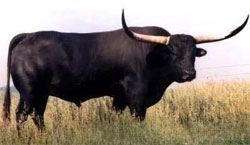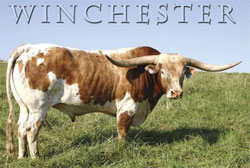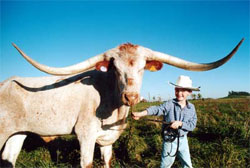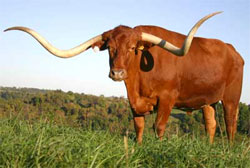Texas Longhorn
History
| Texas longhorn is a breed of cattle known for its characteristic horns, which can extend to 120 inches tip to tip for steers and exceptional cows and bulls in the 70 to 80 inch tip to tip range. Horns can have a slight upward turn at their tips or even triple twist. The first cattle to set foot in North America and the only breed of cattle to evolve without human management, the Texas Longhorn can thrive in country where no other breed can live; subsist on weeds, cactus and brush; range days away from water; and stay fit and fertile whether it’s living in the scorching, parasite-infested tropics or in the arid, subzero winters of Montana. The leaner longhorn beef was not as attractive in an era where tallow was highly prized, and the longhorn's ability to survive on often poor vegetation of the open range was no longer as much of an issue. Other breeds demonstrated traits more highly valued by the modern rancher, such as the ability to put on weight quickly. The Texas longhorn stock slowly dwindled, until in 1927 the breed was saved from almost certain extinction by enthusiasts from the United States Forest Service, who collected a small herd of stock to breed on a refuge in Oklahoma. They were cared for largely as curiosities, but the stock's longevity, resistance to disease and ability to thrive on marginal pastures quickly revived the breed as beef stock. Today, the breed is still used as a beef stock, though many Texas ranchers keep herds purely because of their link to Texas history. In other parts of North America this breed is used for much more. Longhorn cattle have a strong survival instinct and can find food and shelter during times of rough weather. Longhorn calves are very tough and can stand up sooner after birth than other breeds. Longhorn cattle can breed for a long time, well into their teens. There have been cows that have bred for up to thirty years. Some ranchers keep Longhorns for their easy calving. A Longhorn cow will often go off on her own to a safe place to have the calf then bring it home. They are also known to hide their calves in safe places to avoid predation, sometimes causing difficulty for ranchers, who may need to work on the animal.
Suorce: Wikipedia
|
    |